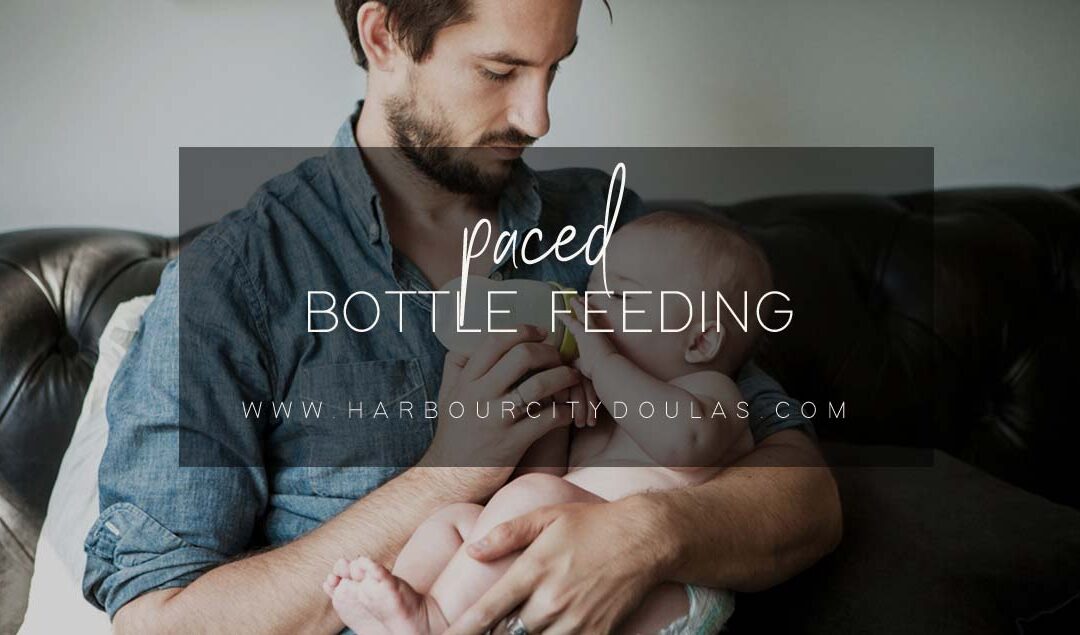There is so much discussion about infant feeding (what, when, how…) that it can be hard to know what the right option for your family is. If feeding time involves a bottle- or if you’re thinking about introducing one for the first time- you may want to read on to learn a little bit about paced bottle feeding and why it’s awesome.
What is paced bottle feeding?
Paced bottle feeding is a method of using a bottle in a more natural way that allows your baby to control more of the feeding the way they do when they’re breastfeeding. Instead of allowing gravity to do most of the work of the feeding, paced bottle feeding lets your baby eat a little more slowly and mimics the work that they’d do during a breastfeeding session. This is a great option for babies that are usually breastfed, but need to take an occasional bottle (but it’s also awesome for babies that exclusively use bottles, struggle to keep up with the flow of bottles, or who tend to spit up a lot).
How do I do it?
There are a few steps to setting up paced bottle feeding. It may feel awkward at first, but give it a few tries for both you and your baby to get used to it. Pretty soon, it will feel just as natural as the conventional bottle-feeding method!
1. Sit baby up straight.
Start by making sure that you are comfy, relaxed, and ready to sit for 10-20 minutes. Your baby should be sitting in an upright position instead of laying down in your arms. You don’t have to have them at a full 90-degree angle (especially difficult for newborns), but higher than 45 degrees is ideal. This prevents the contents of the bottle from simply pouring into your baby’s mouth.
2. Activate anti-gravity technology
Okay, so it’s not that high tech- but unlike in labour, you don’t want to use gravity to do most of the work for you. Instead of allowing the bottle nipple to fill with milk, hold the bottle horizontally (or parallel to the floor) as you tickle baby’s lips with the bottle and coax him to open his mouth (just like with breastfeeding). When he opens his mouth, put the bottle nipple in his mouth and allow him to draw it in as deeply as he’d like. Once he’s latched on, keep the bottle horizontal. Allow the tip of the nipple to fill with milk, but not the base of it. This way, your baby can more easily control the flow of milk or formula as he draws each mouthful in.
3. Take a break
When a baby is at the breast, milk doesn’t flow into their mouth the entire time. Not only does your baby have to work for each mouthful (meaning each suck=more milk appears), but your body has a natural pattern of letdown, milk ejection, and pauses. With paced bottle feeding, our goal is to emulate this pattern by giving the baby a break every so often. Keep an eye on your baby- if he goes tense, starts gulping, widens his eyes, or sputters, chances are he’s getting too much milk and needs a break. Simply lean him forward a little while he’s still latched on, and allow the milk to fall out of the nipple and back into the bottle. Allow a few sucks here, and then slowly lean baby back so that the milk just fills the tip of the nipple again.
4. Know when to call it quits
One of the major benefits to paced bottle feeding is the ability to avoid over-feeding (a common pitfall of bottle feeding). How do you know your baby is full? Well, his sucking will probably slow down, his eyes may wander, and he will probably either start to fall asleep or let his whole body relax. When you think your baby’s done eating (this may or may not be before the bottle is empty), gentle remove the bottle from your baby’s mouth. Offer it again, and if he latches on, allow him to suck for another few seconds before repeating the process again. Eventually, he will either fall asleep, finish the bottle, or not latch on when you offer.
Here’s a great video from Emerald Doulas that shows you exactly what a paced bottle feeding session looks like.
Need some more help? Not sure of the best way to get your breastfed baby to take a bottle? Get in touch with us to book a breastfeeding support visit today!

Recent Comments